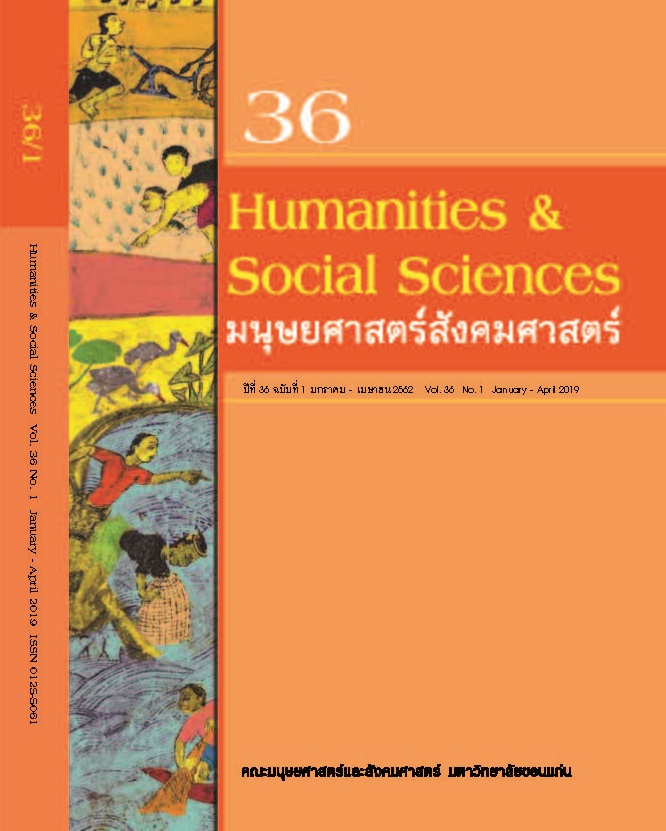ความรุนแรงเชิงโครงสร้างในการทำงานของผู้หญิง: กรณีศึกษาในจังหวัดขอนแก่น/The Structural Violence in The Work of Women: A case of Khon Kaen province, Thailand
Keywords:
Structural Violence, The work of Women, Gender inequality, GenderAbstract
The purpose of this study was to investigate the level of the structural violence and the factors influencing the structural violence in the work of women. The quantitative methodology was employed with individual level as a unit of analysis. The sample consisted of 398 women who are working in government agencies and private enterprise. The samples were randomly by multi-stage sampling technique in 9 municipals of Khon Kaen province. The data were collected using the interview schedule from May to June 2018 and analyzed by descriptive statistics and multiple regression (multi-level) analysis. The results revealed that the most of women samples (55.5 percentages) were in the Generation Y (19-38 years old) and the average age was 37.6 years old. 51.3 percentages of women sample are married, and 43.7 percentages got bachelor’s degrees or higher degrees. They are working (39.9 percentages) in large organizations (more than 200 workers) and 40.7 percentages of the women samples have worked more than 10 years. The result showed that 23.9 percentages of women samples got the structural violence in the work at a rather high level and high level (combined). There were 4 factors that influenced to structural violence in the work of women at statistically significant 0.05 level, included the medium organization, the understanding of female worker’s rights, socialization of gender roles, and self-efficacy in work. All independent variables can explain the variation of structural violence in the work of women at 27.1 percentages (R2= 0.271).
References
กาญจนา แก้วเทพ. (2544). สตรีศึกษา 2 ผู้หญิงกับประเด็นต่าง ๆ. กรุงเทพฯ: อรุณการพิมพ์.
จงจิตต์ โศกนคณากรณ์. (2553). สังคมวิทยาสตรี. (ม.ป.ท): มหาวิทยาลัยรามคำแหง.
จิระพงค์ เรืองกุน. (2560). การกลั่นแกล้งรังแกกันในที่ทำงาน: พฤติกรรม ที่มาและผลกระทบ และการป้องกัน. วารสารมหาวิทยาลัยฟาร์อีสเทอร์น. 11(2), 9-20.
โชติมา กาญจนกุล. (2540). ความรุนแรงในครอบครัว : การศึกษาการทำร้ายร่างกายภรรยา. ดุษฎีนิพนธ์ การศึกษาดุษฎีบัณฑิต สาขาพัฒนศึกษาศาตร์ บัณฑิตวิทยาลัย มหาวิทยาลัยศรีนครินทรวิโรฒ.
ดุษฎี อายุวัฒน์ และวณิชชา ณรงค์ชัย. (2556). ปัจจัยที่มีความสัมพันธ์กับความเข้าใจเรื่องสิทธิแรงงานของ แรงงานนอกระบบ ในชนบทจังหวัดขอนแก่น. วารสารมนุษยศาสตร์ สังคมศาสตร์. 30(1), 17-50.
ไทยรัฐ. (2555). พบสาวไทยเผชิญปัญหา กีดกันการงานตำแหน่งสูงๆ ถูกล่วงละเมิดทางเพศ. ไทยรัฐออนไลน์. สืบค้นเมื่อวันที่ 3 กันยายน 2560, จาก https://www.thairath.co.th/content/243365
ธิติวุฒิ หมั่นมี (2557). การสร้างความผูกพันต่อองค์กรของพนักงาน องค์กรปกครองส่วนท้องถิ่น. วารสารวิชาการมหาวิทยาลัยราชภัฏพระนคร. 5(2), 93-105.
ปวีณา ลี้ตระกูล. (2557). ปัจจัยที่ส่งผลต่อความแตกต่างของค่าจ้างระหว่างผู้หญิงและผู้ชายในตลาดแรงงาน ของประเทศไทย. วารสารเศรษฐศาสตร์และนโยบายสาธารณะ. 5(9), 38-54.
ปาริฉัตร ตู้ดำ และชาลี ไตรจันทร์. (2556). ปัจจัยที่ส่งผลต่อความก้าวหน้าในอาชีพของผู้บริหารสตรีในองค์กร ภาครัฐ: การทบทวนวรรณกรรม. วารสารนักบริหาร. 33(3), 25-32.
นวลพรรณ ไม้ทองดี. (2553). การเลือกปฏิบัติและความแตกต่างของค่าจ้างระหว่างชายและหญิง: กรณีลูกจ้าง เอกชนในวิชาชีพชั้นสูง. วิทยานิพนธ์ปริญญาเศรษฐศาสตรมหาบัณฑิต (พัฒนาการเศรษฐกิจ) สาขาวิชา เศรษฐศาสตร์. สถาบันบัณฑิตพัฒนบริหารศาสตร์ มหาวิทยาลัยเกษตรศาสตร์.
นัฐวุฒิ สิงห์กุล. (2557). แนวคิดสตรีนิยมแนวสังคมนิยม. สืบค้นเมื่อวันที่ 15 กันยายน 2560, จาก
https://nattawutsingh.blogspot.com/2014/01/blog-post_9657.html
นาถฤดี เด่นดวง และสุพจน์ เด่นดวง. (2557). ความรุนแรงในชีวิตแรงงานหญิง. กรุงเทพฯ: ลุคแอดเวอร์ไทซิ่ง จำกัด.
วรรณวิสา แย้มเกตุ. (2558). ปัจจัยที่มีผลต่อการพัฒนาตนเองในการทำงานของพนักงานธนาคารสายลูกค้า บุคคลของธนาคารเอกชนแห่งหนึ่ง. การค้นคว้าอิสระบริหารธุรกิจมหาบัณฑิต บัณฑิตวิทยาลัย มหาวิทยาลัยกรุงเทพ.
วิทยากร บุญเรือง. (2556). การไม่เลือกปฏิบัติต่อแรงงาน การเลิกจ้างที่เป็นธรรม. สืบค้นเมื่อวันที่ 15 กันยายน 2560, จาก https://bact.cc/2013/labour-non-discrimination-fair-dismissal/
สมเกียรติ ชูศรีทอง, ดุษฎี อายุวัฒน์, และสุกัญญา เอมอิ่มธรรม. (2552). การใช้สิทธิแรงงานของลูกจ้างในจังหวัด
ขอนแก่น. บทความการประชุมวิชาการเสนองผลงานวิจัยระดับบัณฑิตศึกษาแห่งชาติครั้งที่ 12 ณ มหาวิทยาลัยขอนแก่น. 12-13 กุมภาพันธ์ 2552. หน้า 1990-2002.
สุเทพ สุนทรเภสัช. (2540). ทฤษฎีสังคมวิทยาร่วมสมัย : พื้นฐานแนวความคิดทฤษฎีทางสังคมและ วัฒนธรรม. เชียงใหม่: โกลบอลวิชั่น.
สำนักงานสถิติแห่งชาติ. (2559). สรุปผลที่สำคัญการทำงานของสตรีในประเทศไทย พ.ศ.2559. สืบค้นเมื่อวันที่ 20 กรกฎาคม 2560, จาก https://service.nso.go.th/nso/nsopublish/themes/files/pocket_work_woman59.pdf
__________________. (2560). สำมะโนอุตสาหกรรม พ.ศ.2560 ข้อมูลพื้นฐานจังหวัดขอนแก่น. สืบค้นเมื่อ วันที่ 7 พฤษภาคม 2560, จาก
https://issuu.com/khonkaen.nso.go.th/docs/2017-industrial-census-basic-inform
สำนักแรงงานจังหวัดขอนแก่น. (2560). รายงานสถานการณ์และดัชนีชี้วัดภาวะแรงงานจังหวัดขอนแก่น รายปี 2560 (มกราคม - ธันวาคม). สืบค้นเมื่อวันที่ 18 กุมภาพันธ์ 2561, จาก
https://khonkaen.mol.go.th/node/1436
อรวรรณ อรุณวิภาส. (2549).ความรู้และการใช้สิทธิจากการเป็นผู้ประกันตนตามพระราชบัญญัติ ประกันสังคม พ.ศ. 2533 กรณีศึกษาลูกจ้างในโรงงานอุตสาหกรรมขนาดกลางและขนาดย่อม จังหวัด สมุทรสาคร. วิทยานิพนธ์ศิลปศาสตรมหาบัณฑิต สาขาสังคมศาสตร์เพื่อการพัฒนา บัณฑิตวิทยาลัย มหาวิทยาลัยราชภัฏวไลอลงกรฌ์ ในพระบรมราชูปถัมภ์.
อภิญญา ดิสสะมาน. (2553). บทความส่งจดหมายข่าวสถาบันพระปกเกล้าลดความรุนแรง ท่ามกลางสถานการณ์ ความขัดแย้งที่ยืดเยื้อ. สืบค้นเมื่อวันที่ 27 สิงหาคม 2560, จาก https://kpi.ac.th/media/pdf/M8_252.pdf
อารยา เชียงของ และคณะ. (2555). ปัจจัยที่มีอิทธิพลต่อการถูกกระทำรุนแรงของพยาบาลในสถาน ประกอบการ. วารสารพยาบาลสาธารณสุข. 26(3), 45-62.
Alessandri, G., et al. (2015). From Positive Orientation to Job performance: The Role of Work Engagement
and Self-efficacy Beliefs. Journal of Happiness Studies. 16(3), 767-788.
Bandura, A. (1999). Social cognitive theory: An agentic perspective. Asian Journal of Social Psychology. 2, 21-41.
Baron, L. and Morin, L. (2010) The Impact of Executive Coaching on Self-Efficacy Related to Management Soft Skills. Leadership & Organization Development Journal. 31, 18-38.
Beauvoir, Simone de. The Second Sex. Translated by H. M. Parshley. New York: Vintage Books, 1989. English translation of Le deuxième sexe (Paris: Gallimard, 1949).
Butler, J. (1988). Performative Acts and Gender Constitution: An Essay in Phenomenology and Feminist Theory. Theatre Journal. 40(4), 519.
Cochran, W.G. (1977). Sampling Techniques. 3rd ed. New York: John Wiley & Sons.
David, B. (1980). Conditioning Diagnostics: Collinearity and Weak Data in Regression. New York: Wiley.
Galtung, J. (1969). Violence, Peace, and Peace Research. Journal of Peace Research. 6, 167-191.
Jacobsen, J. P. (2007). The Economics of Gender. Malden: Blackwell Publishing.
Lindsey, L.L. (2015). Gender Roles: A Sociological Perspective. 6th ed. New York: Pearson Education, Inc.
Matthiesen, S. B. & Einarsen, S. (2007). Perpetrators and targets of bullying at work: role stress and individual differences. Violence and Victims. 22(6), 735-753.
Marx, K. (1970). A Contribution to the Critique of Political Economy. New York: International Publishers.
Miller, S., & Fredericks, M. (2003). The nature of “evidence” in qualitative research methods. International Journal of Qualitative Methods. 2(1). Article 4.
Rakoczy, C. (2017). Employee Rights in the Workplace. Retrieved July 12, 2018, from
https://business.lovetoknow.com/business-operations-corporate-management/employee-rights-workplace
Schwank, D.A. (2013). Barriers for Women to Positions of Power: How Societal and Corporate Structures, Perceptions of Leadership and Discrimination Restrict Women's Advancement to Authority. Earth Common Journal. 3(2). Retrieved July 12, 2018, from
https://www.inquiriesjournal.com/authors/1993/dee-ann-schwanke
United Nations Entity for Gender Equality and the Empowerment of Women. (2016). CEDAW: Restoring Rights to Women. Retrieved January 15, 2018, from
https://www.humanrightscenter.go.th/DocLib4/cedaw1.pdf
Wijk, Christine van and Francis Jennifer (1999). Setting the Stage: Global Trends in Gender and Demand Responsive Water Supply, Sanitation and Hygiene. The Hague, The Netherlands, IRC International Water and Sanitation Centre.
Wood, G.J. & Lindorff, M. (2001). Sex differences in explanations for career progress. Women in Management Review. 16 (4), 152-162.
Yamauchi, F & Tiongco, M. (2013). Why women are progressive in education? Gender disparities in human capital, labor markets, and family arrangement in the Philippines. Economics of Education Review. 32(C), 196-206.



